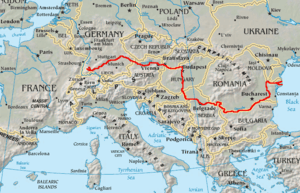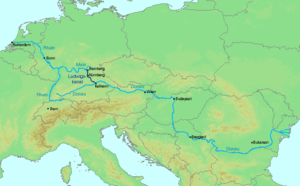Danubian corridor
In paleontology and archaeology, the Danubian corridor or Rhine-Danube corridor refers to a route along the valleys of the Danube River and Rhine River of various migrations of Eastern cultures from Asia Minor, the Aegean region, the Pontic-Caspian steppe, etc., into the north and northwest of Europe.[1][2]

Topography of Europe, with Danube marked red

The Ludwigskanal in the context of the Rhine and Danube
See also
References
- Larson G, Albarella U, Dobney K, et al. (September 2007). "Ancient DNA, pig domestication, and the spread of the Neolithic into Europe" (PDF). Proc Natl Acad Sci USA. 104 (39): 15276–81. doi:10.1073/pnas.0703411104. PMC 1976408. PMID 17855556.
- McCormick, Michael E. (2001). The origins of the European economy: communications and commerce, A. D. 300-900. Cambridge, UK: Cambridge University Press. p. 553. ISBN 0-521-66102-1.
This article is issued from Wikipedia. The text is licensed under Creative Commons - Attribution - Sharealike. Additional terms may apply for the media files.